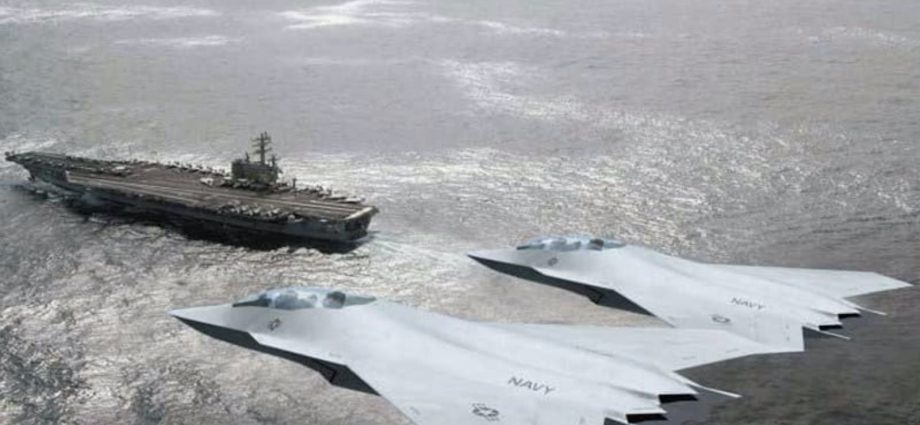The US has just ramped up funding for its next-generation carrier-based fighter in a move that aims to keep pace with China’s recent fighter jet advances.
This week, The Warzone reported that the US Navy requested US$1.53 billion in its proposed 2024 Fiscal Year budget to support the development of the 6th-generation F/A-XX fighter. The program is slated to replace the F/A-18 family of carrier-borne fighters and complement the F-35B and F-35C fighters now in US service.
While there is no consensus on what constitutes a 6th-generation fighter, the type will likely feature technologies such as modular design, machine learning, artificial intelligence, virtual and augmented reality, drone swarms and optionally-manned capability.
The Warzone report also mentions that the F/A-XX is part of the US Navy Next Generation Air Dominance (NGAD) program, a similar but different project from that of the US Air Force.
USNI News notes in an April 2022 article that the F/A-XX will serve as a “quarterback” for carrier-based manned-unmanned teaming operations where “manned and unmanned aircraft plus attritable assets will be employed across domains to enable integrated kinetic and non-kinetic fires at tactically relevant ranges.”
Naval News reported in April 2021 that the F/A-XX would be partnered with multiple types of drones, such as anti-air, electronic warfare and command and control units, which alongside the F-35C will be the foundation of US carrier strike wings in the near future.
The development of the F/A-XX may be a response to the growing obsolescence of the long-serving F/A-18 Hornet and the perceived shortcomings of the F-35B and F-35C carrier-based stealth fighters.
The vast distances involved in military operations in the Pacific attenuate or nullify the advantages of a stronger military over a weaker adversary fighting on its home territory, with the US tending to lose its wars when it fights far from its territories.
In an August 2021 article for Forbes, David Axe says that US carrier-based fighters lack range, citing the failure of a Boeing-led effort to upgrade the US F/A-18 Super Hornet fleet with conformal fuel tanks.

Axe notes that although the F/A-18 is flexible, it can range no farther than 965 kilometers with a heavy weapons load and no aerial refueling, meaning that US carriers must sail closer to their targets, potentially exposing them to enemy attack.
Axe mentions that the F/A-18 Super Hornet Block III’s conformal fuel tanks can add 193 kilometers to the aircraft’s range. Still, testing has shown that the tanks may not be able to withstand the stresses of carrier catapult launches and could complicate maintenance inside the limited space of a carrier’s hangar deck.
He also says that while F/A-18s can extend their range using aerial refueling or island-hopping from different airstrips, large aerial tankers and isolated island outposts are vulnerable to attack.
The aging F/A-18 design thus may no longer be suitable for future Pacific conflicts. USNI News reported in an August 2021 article that the 30-year-old airframes at 10,000 hours might not be viable in the 2050s against new aerial threats.
Asia Times has reported about these potential threats, which include China’s 6th-generation stealth fighter, the J-31/FC-31 carrier-based stealth fighter and the FH-97A Loyal Wingman drone.
China may use its J-20 5th-generation stealth fighter as a base for its 6th-generation fighter, with accelerated manufacturing rates combined with an incremental approach to aircraft development making such an endeavor possible.
Asia Times reported last month that China’s use of pulsed production lines and improved domestic engines might enable J-20 numbers to exceed the US inventory of 187 F-22s.
The US stopped F-22 production in 2011 due to a cost-death spiral at US$143 million per plane, the assumption that China and Russia won’t field competing aircraft until the 2020s, the plane’s irrelevance in counterinsurgency operations in Afghanistan and Iraq, and the reallocation of production lines for the newer F-35, which is more flexible but less capable in air-to-air combat.
Moreover, China’s new J-31/FC-31 carrier-based fighter is designed for air supremacy missions, building on and improving F-35 design data obtained through a 12-year espionage campaign. In addition, the FH-97A Loyal Wingman drone is designed to complement the J-20 in air-to-air operations, with a carrier-based variant under development.

One paradox in modern air combat is while modern fighter aircraft designs emphasize stealth to penetrate enemy airspace and beyond-visual-range (BVR) combat, that emphasis can inadvertently lead to opposing aircraft getting too close to each other, resulting in a dogfight where pilot skills and aircraft maneuverability may give the upper hand over stealth, long-range sensors and weapons range.
The stealthy F-35 may be disadvantaged in such situations. Asia Times noted in December 2022 that the F-35 is sluggish compared to 4th-generation fighters such as the F-16 and would be disadvantaged in dogfights against Chinese fighters such as the J-20 and J-31/FC-31.
However, 2015 tests pitting an F-35A against an F-16D Block 40 saw the former aircraft flying at just a fraction of its combat capabilities due to software restrictions that prevented the pilot from maneuvering the plane beyond its design limits and stopped the use of the helmet-mounted sight to aim weapons while flying without stealth coatings.

